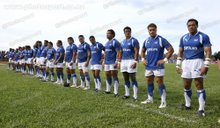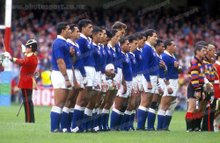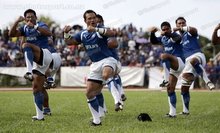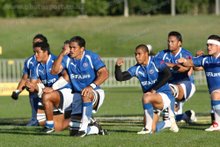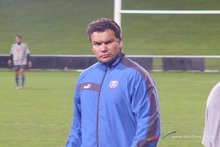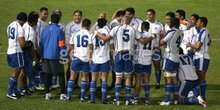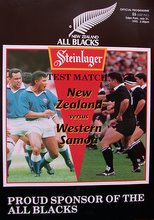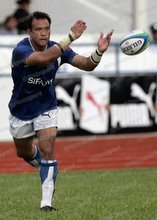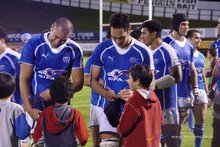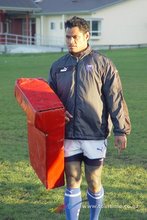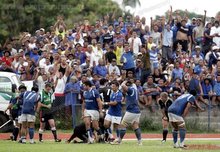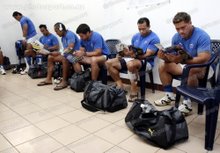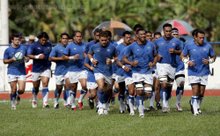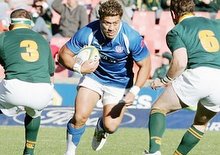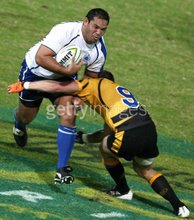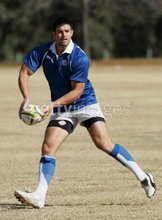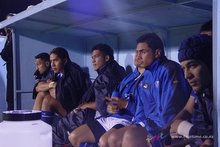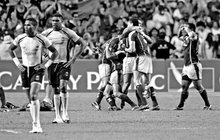The national
rugby union team of
Samoa is called Manu Samoa (the name of a famous Samoan chief some 10 generations ago). They perform a traditional Samoan dance called the
siva tau before each game. They are members of the
Pacific Islands Rugby Alliance (PIRA) along with
Fiji and
Tonga. They are ranked
11th in the world. They have recently been bankrolled by millionaire
Sir Michael Fay, one of
New Zealand's wealthiest men.Rugby was introduced to Samoa in the early 1920s and a
governing body was soon formed.
The first international was played as Western Samoa against Fiji in August of 1924. Along with Tonga, these nations would meet regularly and eventually contest competitions such as the
Pacific Tri-Nations - with Western Samoa winning the first of these. Samoa have been to every
Rugby World Cup since the
1991 tournament. That tournament, along with the
1995 competition saw them make the quarter-finals.
Under their new coach, the All Blacks legend
Michael Niko Jones (himself of Samoan descent and a Samoan international) they are working hard to create a side that will compete effectively in the
2007 Rugby World Cup where they are grouped with
England,
South Africa, Tonga and the
United States.
The Manu Samoa team play in blue and white uniforms
The
Marist Brothers brought the game to Western Samoa in 1920 and
The Western Samoa Rugby Football Union was formed in 1924. On
August 18,
1924 Western Samoa played its first international against Fiji in the capital
Apia, the visitors winning 6-0. The match was played at 7am to allow the Samoans time to get to work afterwards and was played on a pitch with a large tree on the halfway line. The return match was won 9-3 by Samoa to draw the series.
In 1954 Western Samoan visited both Pacific Island neighbours Fiji and Tonga but waited a further 20 years before a tour of New Zealand took place. The Samoans won one of eight matches on that tour.The
traditional tri-series between
Tonga,
Fiji and Western Samoa was established in
1982 with Western Samoa winning the first tournament.
Wales visited Western Samoa and won the test 32-16 at Apia. The tour led to a return visit to Wales which brought Western Samoa out of International limbo, although Western Samoa were not invited to the first
Rugby World Cup in 1987.The following year a 14-match tour of
Europe took place before a World Cup elimination series in
Tokyo, which gave Western Samoa a place in the
1991 Rugby World Cup in
Britain.
They made a huge impact. After sweeping aside Wales 16-13 in
Cardiff and defeating
Argentina 35-12, and narrowly losing 3-9 to eventual champions
Australia in their pool match, Western Samoa, a country with a population of 160,000, found itself in the quarterfinals against
Scotland at
Murrayfield. The Scots, however won comfortably, 28-6, but the Samoans were clearly the personality team of the tournament.Over the next two years the side had a number of notable wins. The most outstanding achievement were in Sevens where it won the 1993
Hong Kong and 1992
Middlesex Sevens.
The
1995 Rugby World Cup in
South Africa proved that the team belonged in top company. They again reached the quarterfinals after wins over Argentina and
Italy, but were beaten 42-14 by the eventual winners
South Africa. After the Cup, Manu Samoa made a 13-match tour of England and Scotland, drawing 15-15 with the Scots and going down 9-27 to
England.With the advent of professional rugby in 1995 it was vital for Manu Samoa to developed a new administrative structure.
This was made possible with Fay Richwhite and the Western Samoan Rugby Union joining forces to form Manu Samoa Rugby Limited, which now manages business for the team. Samoa emerged from the
1999 Rugby World Cup with honour intact after another shock 38-31 victory over host nation
Wales in the pool stages. They again lost out to Scotland in the quarter final play-off.Manu Samoa qualified for the
2003 Rugby World Cup with a 17-16 defeat by Fiji,
Earl Va’a missing an injury-time penalty. They recovered to beat Tonga both home and away and avenged that Fijian defeat with a 22-12 win in
Nadi. They ultimately had to settle for second place in the round robin, behind Fiji on points difference, and a place in the tougher of the two Rugby World Cup 2003 pools alongside automatic qualifiers England and South Africa. In one of the games of the tournament they led eventual champions England for most of the game before losing 22-35.
The New Zealand ConnectionWestern Samoa's triumph in the 1991
Rugby World Cup was inspired by their coach
Bryan Williams who had been the first Samoan-born player to transfer his allegiance to the
All Blacks. Since Williams many Samoans have pursued their rugby careers in New Zealand provincial rugby and the best of these have been snapped up by the All Blacks.
However, many of these players have been educated in New Zealand from an early age, developing their rugby skills within the very challenging New Zealand secondary schools competition.
Malili Muliaina,
Jerry Collins,
Isaia Toeava and
Casey Laulala are just four of the many Samoan-born players who have chosen to represent New Zealand, after having been educated there.In recent times New Zealanders of Samoan descent have been key members of the
All Blacks squad, including past New Zealand captain
Tana Umaga.
In some Test matches on their 2005
Grand Slam tour of the
Home Nations New Zealand fielded a side packed with players of Samoan descent. New Zealand born players with Samoan parentage have also played for Samoa, such as Earl Va'a, Pat Lam and Lome Fa'atau.The rugby relationship that exists between New Zealand and Samoa is undoubtedly a complex one. Close ties exist between the two countries, these bonds first being formed with the start of mass Polynesian migration to New Zealand in the latter half of the twentieth century. Naturally, many players eligible for Samoa have chosen to play for the All Blacks, recognising the obvious potential for financial and sporting rewards. Also, unfortunately, because of current international eligibilty laws, many Samoans who commit themselves to playing for the All Blacks find that they are unable to play for the smaller nation when their dreams of pulling on the black shirt are unrealised.






